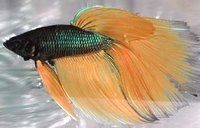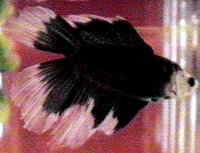Tropical Betta Fish

Description:
The betta or Siamese fighting fish is very well known. Along with goldfish and guppies, they are commonly kept and usually it less-than-ideal homes. The betta, Betta splendens, is a small labyrinth fish from Thailand, Cambodia, and nearby areas. It is able to use oxygen in air to survive. Thus, it can live in small and/or polluted waters. Males do not tolerate other males. It is for this reason that males are kept in tiny containers of water by themselves. Females are rarely even sold. They are a little smaller or seem so because their fins are much shorter. They have less flashy coloration and are more tolerant of other bettas.
Males grow to about three inches and are brightly colored. Colors may include green, red, yellow, orange, purple, blue, white, black, and more! Most bettas are mostly red or blue/green. Females contain these same colors but more in a pastel shade. They have more apricot colored areas too (non-colored). Females grow to about two inches.
Setup and Water Preferences:
Bettas like soft, slightly acidic water. A pH from about 6 to 8 will do. They need warm temperatures of at least 75 degrees F but can take short periods (less than a day) in the 60's. Low temperature is one of the most frequent causes of death for bettas. They do not do well at "room temperature" if that temperature is below 75 degrees F for long periods of time. One disadvantage of keeping them in cups and bowls is this lack of temperature control. For a fish that can take down to about 50 degrees F in a bowl, a paradise fish is a better choice (although it is a bit larger and more active and would prefer a tank).
Bettas prefer to eat small, live foods but will eat most small, meat-based foods. Live brine shrimp are a favorite food. My betta ate brine shrimp on his first day with me but strangely on the second day, he took every live brine shrimp he could find into his mouth and then spat them out! Then, he switched to flakes! Many bettas like the small pelleted foods. Bettas spend most of their time at the water's surface so they find it easiest to eat floating foods. My betta also explored other levels in the tank but slept at the top.

Betta Housing:
Male bettas are sold to be kept in tiny containers of water all by themselves. Because they can gulp and use atmospheric oxygen, they can survive in small puddles of water or small cups. But, just because they can does not mean they have to do so or even should. I put one in my 20 gallon community tank (see below for precautions). He was a bit confused at first, never having seen other fish, plants, and room to move! But, then he loved it! Bettas kept in less than a gallon of water should have the water changed at least a few times a week or as it gets dirty. Because males fight with one another, breeders with lots of fish have no choice but to keep the fish individually in small containers, like bowls, vases, or pickle jars. Bettas are often sold with a "betta vase" which is just a small container usually with a plant stuck in it. While a few microbes or algae might be on the roots short term, the betta will quickly eat those. He may pick at the roots to gather oxygen as well. But, the betta cannot live off the plant alone and must be fed at least a few times a week. Small containers can also foul quickly so frequent 50% water changes are good. The water should never be cloudy or stinky. If you would not drink it based on how it looks (not knowing a fish had been in it), it is not fit for your betta. Please do not keep bettas in tiny containers. See this site for more information.
Compatibility of Bettas with Other Fish:
A male betta attacks other males, females when he sees fit, and fish that HE thinks look like a betta too. He will "fight" with his reflection. Fighting males spread out their gills like wings, lunge, and bite off pieces of fin. Fish with flowing fins may find them nipped by a male betta. These include fancy goldfish (who do not like the heat that a betta likes anyway), fancy guppies, and other longfinned fish. Female bettas are more tolerant. They generally can tolerate other females but there are tales of females who think they are male and nip other fish. Fast moving and nippy fish like many barbs and danios will often nip at slow bettas' fins. If a male betta is put in a warm community tank with no other fish that looks like a betta (no flowing fins) and no fish that may nip or eat him, then he will get along fine. Goldfish and bettas are not a good mix. This is for a number of reasons: the betta may nip the goldfish, the goldfish may pester the betta to death or rip his fins, the goldfish likes it cool while the betta likes it warm, and the piggy goldfish will eat any food added for the betta. Single-finned goldfish grow over a foot long while bettas stay at an inch or two. Goldfish like to move around at a good pace making a mess while bettas like to take their time to move around. I love both goldfish and bettas but just not together.
Sexing:
A male betta has bright colors and long fins. An average female has more subdued colors and shorter fins than a male. Some females are more colorful and can be mistaken for males but are generally smaller. When ready to spawn, her abdomen will enlarge with eggs. Because females are rarely sold, most bettas encountered (usually in cups) are male.
Breeding:
Males will build a bubble nest in water less than six inches deep that has floating plants and no water movement. A breeding setup should not have running filters or aeration, or the nest may be destroyed. Floating plants will anchor it in place. Usually, a male and female are conditioned separately but in sight of one another (in two half-filled five gallon tanks for example). They are fed live foods. The male should build a nest as the female's eggs develop. When the nest looks done, and the female is fat, they can be put together. He may bully her. If he gets violent, they need to be separated. Otherwise, they will spawn, and he will put eggs in the floating nest. After her eggs are all out, she should be removed as he will then attack her to protect the nest. Fry hatch in about 24 hours at 80 degrees. Newborns can eat infusuria, egg yolk, and maybe even crushed flakes. Breeding is reported to be easy but it is vital to remove the young males into separated quarters as soon as their sex is apparent.






<< Home